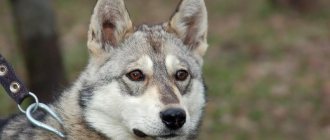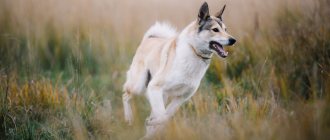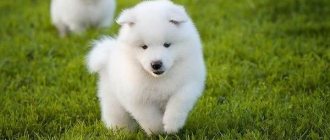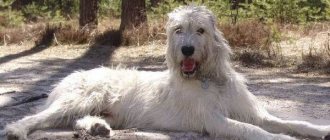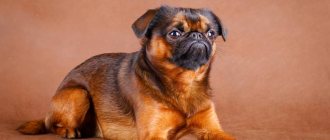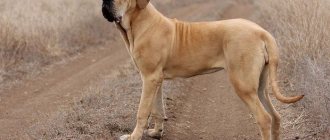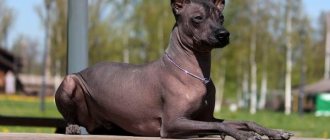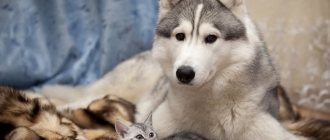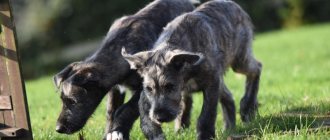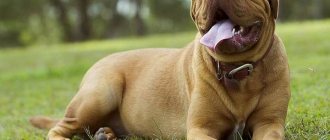The West Siberian Laika is considered the most versatile assistant for a hunter, and no other dog can compete with it in this regard. In Russia, huskies are very popular. The main reason for such interest in this breed is the unpretentiousness of keeping these animals. Laika becomes very attached to its owner, taking on the lion's share of hunting responsibilities. These animals demonstrate all their natural skills while hunting a wide variety of animals and birds that live in our country.
Description and features
Experts draw data on the history of the origin of various ancient dogs from chronicles. Unfortunately, nothing was preserved about the West Siberian Laika breed However, it is claimed to be one of the oldest dogs in the world, with a history of discovery dating back more than 1,000 years ago.
According to the most common opinion, in Ancient Rus', huskies were exploited as ordinary yard animals guarding buildings and livestock. Men also often took them with them hunting. This is due to the versatility of the breed. Its representatives actually perform many functions, from companionship to hunting.
Let's take a closer look at the last function. Laika is not only hardy, but also very strong and fast. She is capable of catching up with a deer, elk or even a ferocious boar in dense terrain. A dog that is not bloodthirsty by nature, of course, cannot win a fight with the last beast, so it hunts only in pairs with its owner. What also makes this dog versatile is its ability to catch swamp animals.
It is better that the owner of such a pet, who goes hunting with him into the forest, has a gun with him. In the forests of Siberia, where huskies are most often exploited for this purpose, there are many wild ferocious animals that can be the first to attack a dog, crippling it. Therefore, it is not advisable for her owner to go there with her without having a weapon.
Further. The representative of the breed is an adequate and reliable watchdog. He deservedly takes his place in this career niche. Trains well and quickly, is open to new information, and easily assimilates it.
As for sociable inclinations, the West Siberian Laika definitely has them. The animal quickly gets used to the house, the people who live there, and strives to protect them at all costs. Loves everything new. At home, he regularly explores the territory and strives to please himself by searching for interesting objects. The curiosity and activity of huskies knows no bounds.
The owner of such a pet must always remember this. An unemotional life will make such a dog unhappy. She is bright and energetic, so she needs regular feeding with new things. We are talking about the need for frequent walks with her, meeting different people and animals, buying beautiful toys for her, etc.
Buying a West Siberian Laika puppy
ZSL is a fairly common breed in Russia, and it is especially popular among hunters. Therefore, there should not be any problems with its acquisition. The cost of this dog is 5,000–20,000 rubles. Show dogs will cost more. But it is worth remembering that there is always a risk of running into unscrupulous sellers who are trying to sell low-quality “products”. In order not to become a victim of scammers and not to purchase an ordinary mongrel dog for a lot of money, you need to follow some tips:
- It is better to purchase a puppy from a nursery than from someone else;
- The optimal age of the puppy at the time of purchase is 3 months;
- the puppy should be moderately active and look healthy in appearance;
- puppies of three months of age already have the same breed characteristics as adult dogs, so you should focus on the generally accepted breed standard;
- You should not take the largest pet, as there is a high risk of obesity;
- you should inquire about the working qualities of the puppy’s parents;
- It’s worth finding out what kind of litter the female has and how often she gives birth. The best option is when the bitch gives birth once a year. Puppies from the first litter are considered weaker.
Puppies from the first litter are considered not entirely successful
Male puppies look impressive, but they are more independent and prone to running away. Females are flexible and easier to train. The only negative is estrus, which prevents normal hunting.
Breed standard
The West Siberian Laika dog is a medium-sized breed, although some experts classify it as large. The dog's physique is proportional, he is well built. It is believed that it was selected for many years. Ancient representatives of the breed were much larger than modern ones.
However, their massiveness deprived them of such an important skill necessary for hunting as agility. According to the standard, the weight of a normal representative of the breed should not exceed 20-23 kg. Some young females weigh 15-15 kg and this is not a deviation. The height of an average-sized individual is 58-60 cm.
It must be said that the above parameters are not so important for the judicial analysis of the West Siberian Laika. Experts evaluate this animal, first of all, by the harmony of its body parts, that is, they analyze how well it is built.
The dog's body is elongated. The neck is not long, has a barely noticeable bend. The ribs are not visible at all on the muscular, broad back. The withers are perfectly expressed. The chest is not wide, not protruding. On strong and symmetrically placed legs, the knee joints are well defined. The tail is ring-shaped, most often lies on the back, but can hang to the side.
The wedge-shaped head is slightly elongated. The transition to the muzzle is smooth. The dog's jaw is tightened, his lips are dry, his teeth are snow-white and strong. According to the standard, the bite of a purebred husky should be scissor-shaped.
His ears are triangular, have pointed corners, and erect. The nose is large, pigmented, often black. The look of the West Siberian Laika in the photo is expressive and interested. Her almond-shaped eyes are set shallowly. Their shade is black or dark brown.
All dogs bred in Siberia have a dense undercoat. It performs an important protective function of insulation. The animal is not afraid of frost and blizzard. The dog's fur grows straight, vertically in relation to his body, this gives the impression that he has a fluffy fur coat.
The dog's appearance is really bright and elegant. There are a lot of colors. Popular options:
- Pure white.
- Sandy brown.
- Pure brown.
- Ginger.
- Red-gray.
- Black and white.
West Siberian Laika color
COLOR:
- zone gray,
- zone-red,
- grey,
- ginger,
- pale yellow,
- reddish-brown of all shades;
- pure white or two-color (piebald) of any color listed above and similar to the main color.
Character
If you have read or heard somewhere that the West Siberian Laika is a very kind and tame pet, you should know that you have been misled. This thesis is only partly true. There is something wild in the character of such an animal; it is not for nothing that its appearance resembles a wolf.
No, it is definitely possible to tame this dog, but do not expect it to serve you, like, for example, a Labrador or a German Shepherd. This animal is distinguished by its willfulness, some obstinacy and self-confidence. It is recommended to build a partnership relationship with him. What does this mean?
As an assistant and unquestioning servant, such a dog is ineffective. But as a comrade helping to complete a task that is interesting to him, it’s the opposite. Partnerships provide for mutual benefit. The owner gives his pet shelter, takes care of him, trains him, and he, in turn, protects his home, goes on a joint hunt and gives love and tenderness.
Despite their pretty appearance, none of the famous huskies can be called absolutely good-natured. She can snap if any living creature, even a person, begins to behave too intrusively. Being in a bad mood (and this happens periodically with these beautiful dogs), he moves away and spends time alone. Needs personal space.
Not prone to strong excitability. Almost always behaves appropriately. Loves order and certainty, cannot stand chaos. In principle, the Laika is a good and positive dog that easily becomes attached to its owners. She loves to sleep at their feet, spend time together, but most of all she likes going to the forests together.
In densely growing areas it can demonstrate all the hunter’s talents given to it by nature. For example, there are cases when a representative of this breed, at the time of a foray, disappeared into the forest for some time, after which he brought a killed bird or fish to his family members.
Another interesting feature of West Siberian huskies is their flexible intelligence. The ability to make decisions independently and learn quickly are the things that make a dog valuable, and the representative of the breed in question has them.
Well, excellent working potential is passed on to him genetically. Modern West Siberian Laikas are in no way inferior to their ancient and more massive ancestors. They are clever, fearless, inquisitive and very loyal.
It is also worth highlighting a few more specific aspects of the character of such dogs. They truly hate most species of animals. This is due to well-developed hunting instincts. However, thinking that this applies to people is a mistake. Although, they often react warily to suspicious strangers.
The interesting thing is that these wonderful dogs are monogamous. In the world of living nature, this concept extends to those who remain faithful to one living creature. The West Siberian husky will never change its owner; once it becomes attached to a person once, it will remain faithful to him all its life.
Care and maintenance
Keeping it in a yard or a spacious enclosure is the best option for a representative of the breed. They will be uninterested and completely joyless living in the same apartment with the owners. This is a skittish breed, prone to mood swings, so sometimes it needs to be alone.
If you live with a husky in the house and keep it outside, do not forget to go out to spend time with it every day, it is better to do this several times. Also, do not ignore her natural need for walking.
Yes, a dog can relieve itself outside, but it also needs walks to gain new sensations. Don't deprive your pet of the opportunity to explore the world the way he wants. Give him freedom.
Laikas are not prone to self-indulgence or distracted behavior, so they will not run away if you let them off the leash. But, if there are other dogs nearby, it is better not to let the animal go, as it will certainly start a conflict with them.
What you definitely shouldn’t do is put a husky on a chain! This proud Siberian dog will not faithfully serve a man who will limit his freedom so much. Moreover, such a life will make the animal as unhappy as possible.
About care. The first thing you should pay attention to is the dog's fur. In huskies it is lush and straight, well protected from contamination. However, it is recommended to clean it once a year. Without this, the animal begins to smell unpleasant. Which shampoo to choose? You should buy a special detergent for your dog from a pet store. You cannot wash it with human hair shampoo.
Unfortunately, representatives of the breed often face such an unpleasant problem as tartar. It forms on the surface of his fangs. The best prevention is regular mouth cleaning.
Of course, your dog will not be able to brush his teeth on his own, no matter how smart he is. Therefore, he will need your help. In addition to regular oral brushing, give your pet soft bone cartilage regularly. This will help him get rid of tartar and plaque.
Ears are one of the most vulnerable places of a husky. They are often exposed to infections and parasites, especially if she regularly hunts in the forest. They should be inspected every week. You need to wash your ears regularly, but it is important to make sure that water does not flow into them!
Use a cotton cloth or cotton wool soaked in warm water to wipe their surface. It is also necessary to monitor the condition of your pet's eyes. They should not be sour or inflamed. Wash his face.
You should sharpen your dog's claws only if, for some reason, he does not do it on his own. Most active and nimble huskies do not need this procedure.
History of the breed and its psychological portrait
As you know, the West Siberian Laika was bred on the basis of 2 breeds. In the 20th century, cynologists from Russia created standards for huskies. Most likely, the formation of the breed would have been impossible if specialists had not selected animals for the best hunting qualities: endurance, speed, developed hearing, vision and scent.
The brave dog will become an excellent companion to the owner and an excellent hunter. The dog quite quickly becomes attached to the person who raises him. From loneliness, a dog whose color is very beautiful can get sick. Therefore, she needs to pay maximum attention.
The pet is kind and balanced. He is good with small children. However, the Siberian character makes itself felt. The dog can become aggressive when provoked for a long time. Very often, males have a desire to dominate among dogs.
As you know, the West Siberian Laika was bred on the basis of 2 breeds. In the 20th century, cynologists from Russia created standards for huskies
Having chosen this breed, you need to be prepared that huskies are very active, and you should work with them every day and teach them commands. This way, the dog will not accumulate excess energy.
Nutrition
A ready-made diet (dry food) is perfect for the West Siberian Laika. She should eat at least 800 grams of this product per day. Don't skimp on it! Buy only premium food. How to distinguish good dry food from bad? Answer: by composition. In a quality product, the main ingredient should be meat.
If your pet is fed dry food, periodically feed it with offal, fortified foods, for example, berries or vegetables, bone cartilage, fermented milk, etc. What definitely should not be included in its menu:
- Fatty foods cooked in oil.
- Pastries, cream cakes.
- Expired products.
- Fat cottage cheese.
- Stewed lamb or pork.
- Fatty fish with bones.
- Chocolate and marmalade.
Remember, your husky should eat plenty of vitamins at any time of the year, so never deprive her of the pleasure of eating a banana in winter or a fresh tomato in summer.
Reproduction and lifespan
West Siberian huskies live on average 13 years. These are hardy and energetic dogs that are adapted to live in conditions of low temperatures, strong winds, frosts, etc.
The breeder must know all the requirements for representatives of the breed, outlined by the standard. He must select candidates for mating, firstly, who are sexually mature, who are older than 2.5 and younger than 7 years, and secondly, who are adequate in behavior.
Healthy and healthy offspring will be produced by calm and good-natured dogs that show sexual interest in each other. The bitch should not be aggressive towards the male, otherwise it will not happen.
If her behavior is too aggressive, the meeting is postponed. Probably, after meeting this male the day before, she will become more accommodating towards him.
In order for the mating to definitely end in conception, it is advisable to introduce the male to the female in the middle of her estrus period, approximately 3 days after its start. Within 67-70 days after this, puppies will be born.
Malformations of the breed
A defect in the development of a breed is interpreted in terms of the degree of its manifestation.
Flaws:
- slight sexual deformity;
- high excitability;
- Aquiline nose;
- light brown eyes;
- disturbance in the color of the nose and lips;
- absence of no more than 4 premolars;
- low-set ears;
- straightened shoulder-scapular joints; twisted elbows;
- flat ribs, shallow chest;
- flat or splayed paws;
- small spots on the head and limbs;
- sparse undercoat, brushes, muff, sideburns;
- restricted movements;
- height deviation is +2 cm in females, and -2 cm in males.
Vices:
- obesity or thinness;
- sudden stop;
- snub nose;
- short muzzle;
- saggy lips;
- violation of pigmentation of the nose, lips, eyelids;
- straight-set, round, bulging eyes;
- loose eyelids;
- the presence of not all teeth;
- small teeth;
- round, large ears;
- sagging or hunchbacked back;
- narrow, straight, sagging, hunchbacked or sunken lower back;
- small breasts;
- tail too short or too long;
- clubfoot;
- paws turned inward or outward;
- excessively pronounced or straightened angles of the hind limbs; twisted knees; cow or goat hind limbs;
- unnatural heavy gait;
- long curly coat;
- significant speckling of the same shade as the main color on the head and limbs, speckling on the body;
- specks of a different color than the main color;
- black or black and white color;
- deviation from standard height by more than 2 cm in either direction;
- The height at the withers is less than the height at the croup.
Disqualifying faults:
- high degree of aggressiveness and timidity;
- bite problems;
- distorted jaws;
- 4 or more missing teeth. Extra incisors;
- clouding of the cornea, eye color interspersed with a different color;
- hanging or semi-erect ears;
- short or straight tail;
- short-haired or long-haired;
- brown, blue, brindle colors.
Video: ZSL - universal hunter
Price
Where is the best place for a dog owner to buy a pet? Of course, in the nursery. In this place he will definitely not be deceived; he will be provided with all the documents, from a passport to a pedigree, and will be taught how to raise, care for and treat a dog. This purchase is also good for long-term cooperation.
Most kennels of purebred dogs provide a guarantee on them. This means that in the first year after purchasing an animal there, you receive long-term assistance in caring for it.
No, an employee of this institution will not come to your home to comb your dog, but he will certainly advise you over the phone on this issue and many others. The average price of the West Siberian Laika in Russia for 2022 is 15 thousand rubles.
Origin story
It has been precisely established that the ancestors of huskies are outsider wolves who left the pack and joined people. The homeland of huskies is considered to be Western Siberia, where wolves mixed with local hunting dogs.
In pre-revolutionary Russia, the descendants of wolves were actively used in hunting by the Khanty and Mansi peoples . Laikas became constant companions of Soviet hunters.
In the first years of Bolshevik rule, the state needed a large amount of furs in order to sell it abroad, receiving foreign currency in return. And the main suppliers of fur were Siberian hunters. Sables, martens, raccoons, and squirrels brought in foreign currency, so the authorities tried in every possible way to help the hunters. The help also touched our constant companions – huskies.
- In 1925, an official description of the breed was compiled and published, where the varieties were classified according to the ethnographic principle proposed by A.A. Shirinsky-Shikhmatov. The standards were created by fans of the breed, led by I. Vakhrushev. The description turned out to be confusing, but it allowed us to start working on breeding huskies.
- In the 1930s, a section of husky lovers was organized. It was headed by zoologist and geneticist S. Bogolyubsky. Subsequently, the section was chaired by famous dog handlers: I. Vatrushev, P. Pupyshen, A. Fedosov.
- In 1939, the All-Union Cynological Meeting was held, as a result of which temporary standards for five varieties of huskies were adopted and it was decided to begin breeding them.
The work on huskies was entrusted to the leading Soviet nursery “Krasnaya Zvezda”, but breeding was carried out in other nurseries - in the Moscow, Sverdlovsk, Novosibirsk and Perm regions.
The selection of breeding dogs in the Urals was carried out by dog handler N.B. Poluzadov. The ancestors of modern West Siberian Laikas were the males Dzhubar and Taezhny.
The Great Patriotic War did not prevent breeding work on huskies - the state’s need for currency became even greater: it was necessary to purchase equipment and products abroad.
In 1942, Zagotzhivsyrye and Tsentrosoyuz founded about 70 nurseries specializing in hunting dogs. Of these, 25 bred only huskies, and in another 27 huskies predominated. This attention allowed the breed to endure the hardships of war without problems.
Altair
I'm Altair, the site's mascot!
Ask a Question
In 1949, Soviet dog handler, author of books on dog breeding E.I. Shereshevsky put forward a proposal to change the classification: he believed that crossing of huskies occurs within individual regions. The proposal for a geographical classification was adopted in 1952.
New standards were drawn up and approved in 1954. There are four varieties left:
- Russian-Finnish huskies;
- Russian-European huskies;
- East Siberian Laikas;
- West Siberian huskies.
Aboriginal taiga huskies, German shepherds and dingoes left their mark in the gene pool of West Siberian huskies . Experts still divide West Siberian huskies into two types, which differ slightly in appearance:
- Khanty (for cold, harsh climates);
- Mansi (for dense taiga).
The West Siberian Laika reached its peak of popularity in the 1960s and 1970s. The dogs won shows, their versatility appealed to hunters all over the world. The International Canine Association officially recognized the West Siberian Laika in 1980. This is the most common type of husky.
Education and training
All service dog breeds need a leader, that is, a leader. Do not forget that the dog is a pack animal that should be socialized in a group and led.
A husky prone to dominance can snap, steal food from the table, bite other animals in the house, sleep anywhere, that is, be a problem for the family. Unfortunately, representatives of this breed are often abandoned. But, with proper upbringing, they become quite adequate and well-managed.
We advocate that anyone can learn to raise a service dog correctly, without professional help. Laikas are by nature inquisitive, trusting, but a little wild.
From this it follows that for successful training they should be interested. The best option is to give the animal a treat. Give the animal the opportunity to gain confidence in you, let it associate your voice and hands with “yummy.” Then it will definitely listen to you.
The first thing you should teach such a dog is to remember his name, that is, his nickname. Let each family member call him by name, call him to him, and then good-naturedly pat him on the withers or head. Giving a treat in this case also won’t hurt.
When the dog remembers its name, start training basic commands: give paw, lie down, no, sit, etc. There will be no specific recommendations here, the main thing is to hone the dog’s skills to the point of automaticity, and this requires a lot of practice.
Training with a leash and collar is equally important. This is the standard home equipment needed to train the West Siberian Laika. A leash is a visible connection between a man and his dog. The first determines how durable and long-lasting it will be.
In order for your dog to approach you with pleasure, you should not shout at him; let him associate the collar and leash with an interesting walk. But before she goes outside the house, she must get rid of her excitement.
A common mistake made by inexperienced dog owners is going out with an excited dog. Most four-legged pets get very happy at the sight of a leash and do not calm down for a long time. Going out into the yard with them means encouraging an unstable mental state. First, you need to give the animal the opportunity to calm down and only after that, walk it.
Other equally important rules for raising huskies:
- Scold and shame her for damaging interior items. Poke the dog’s muzzle into the thing that has been damaged, and then isolate it from yourself.
- Do not allow people to relieve themselves indoors. It is important to teach a West Siberian husky puppy to look for a latrine only outside, and in any weather.
- You should not allow your animal to jump on your home furniture.
- Control the process of his acquaintance with cats, mice and other animals in the house.
- Do not allow him to develop food aggression (roaring during meals). If your dog gets angry while eating, gently toss something tastier into his bowl, such as cheese. This will stop her from associating you with a threat. Your hands will become a pleasant symbol for her.
Breed characteristics and character
Before moving on to the description of the West Siberian husky , it is worth noting one interesting fact: the dogs got their name not so long ago, and previously huskies were called ostroushki.
The history of the breed goes back to the Siberian regions and the Urals. Harsh conditions and natural selection did their job: a dog with a thick undercoat, warm fur, strong build and excellent health could survive even in severe frosts.
West Siberian Laika on a walk in summer
The breed's resistance to weather anomalies played into the hands of hunters - they identified the dog as a gun dog and a guard dog. The Ostroushki herded livestock, guarded the home, and helped carry firewood and supplies for the winter.
Over time, the versatile workhorses were eventually noticed by dog handlers in the 1920s. Then their active breeding began. From the Mansi and Khanty varieties of Laika, the common, West Siberian Laika appeared.
During the Great Patriotic War, the dog worked at the front, and today it helps transport cargo, deliver the wounded, and search for explosives. She is often hired by intelligence agencies.
Today there are four varieties of huskies:
- West Siberian;
- Karelian-Finnish;
- Russian-European;
- East Siberian.
Laika is one of the rare dogs that has a multifaceted character. Like people, this breed's temperament depends on the conditions in which it grew up, on upbringing and socialization, and on whether its natural needs were satisfied. Two dogs born at the same hour from the same mother can differ radically in their disposition.
West Siberian Laika puppy
The future owner should know that this dog, like no other, needs speedy socialization. Otherwise, an embittered, aggressive dog will grow up. Training of the West Siberian Laika is mandatory and should be carried out from a young age.
Interestingly, learning can be multidirectional. If the dog is used for hunting purposes, then training occurs according to one strategy, and if it is needed to guard the house, then it is trained differently. The intersection of both strategies is possible.
Basic training should begin as soon as the dog arrives at its future home. As clearly as its name, the dog must know the commands “near”, “place”, “no”. If the owner doubts his abilities, he can turn to professional trainers.
Possible diseases and methods of treating them
The West Siberian Laika has no hereditary diseases. However, even these strong dogs end up at the veterinarian's office with dislocated and broken legs. Typically, limbs are damaged only by those individuals that regularly hunt in the forests with their owners.
There are practically no preventive measures aimed at minimizing the risk of injury to limbs during hunting. It is important to take your dog to the hospital in a timely manner if he tightens his limb and whines loudly. These symptoms clearly indicate injury.
To keep your dog healthy, be sure to check his teeth, eyes, and ears regularly. They will have to be systematically looked after. And, of course, improve your pet’s health with vitamin complexes for animals.
Training
The main task in training dogs of this breed is to teach them unquestioning obedience. Lessons start at an early age. First, puppies are taught basic commands and only from 10 months they begin special hunting commands. Although the experience of many hunters has shown that training can begin earlier. From this period, training should take place at specialized sites that recreate the conditions that will be encountered during the hunt. At this time, puppies are accustomed to the sounds of gunshots, headlights and other moments that should not distract or frighten the dog.
